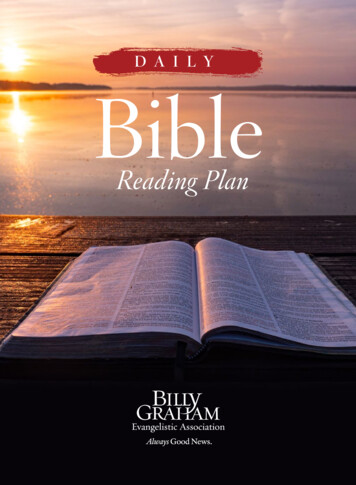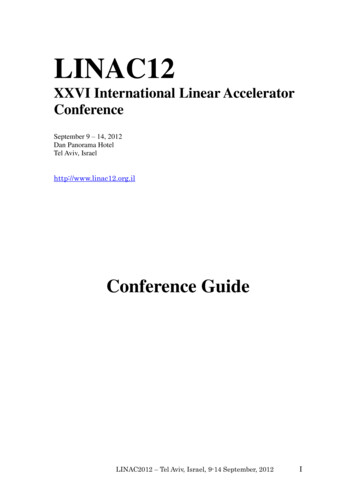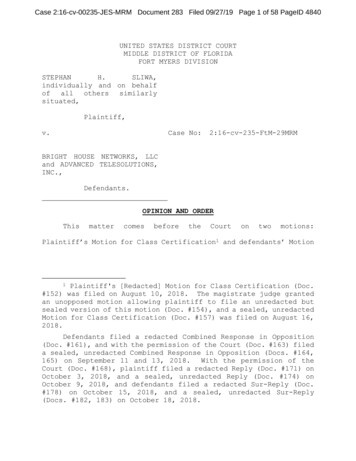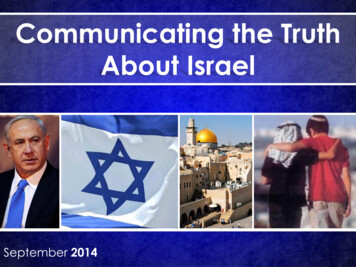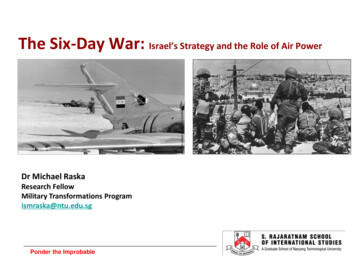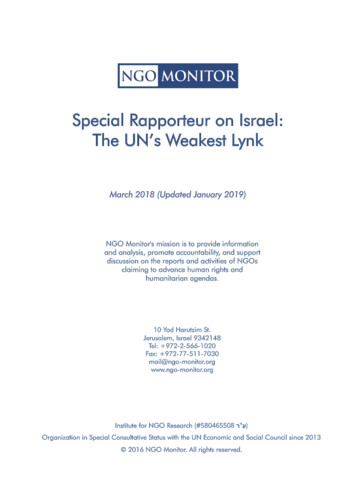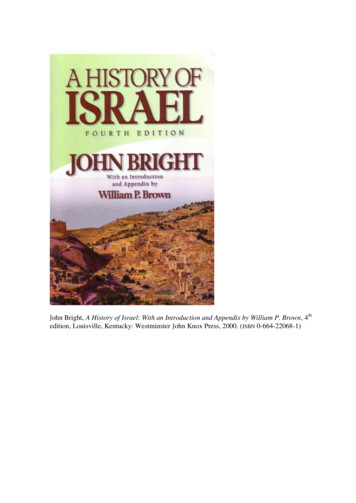
Transcription
John Bright, A History of Israel: With an Introduction and Appendix by William P. Brown, 4thedition, Louisville, Kentucky: Westminster John Knox Press, 2000. (ISBN 0-664-22068-1)
ABBREVIATIONSAASORABAJAAJSLANEHAnnual of the American Schools of Oriental ResearchThe Anchor Bible, W.F. Albright (†) and D.N. Freedman, eds., (New York: Doubleday)American Journal of ArchaeologyAmerican Journal of Semitic Languages and LiteraturesW.W. Hallo and W.K Simpson, The Ancient Near East: A History (New York: HarcourtBrace Jovanovich, 1971)ANEPJ.B. Pritchard, ed., The Ancient Near East in Pictures (Princeton University Press, 1954)ANETJ.B. Pritchard, ed., Ancient Near Eastern Texts Relating to the Old Testament (PrincetonUniversity Press, 1950)ANE Suppl. J.B. Pritchard, ed., The Ancient Near East: Supplementary Texts and Pictures Relating to theOld Testament (Princeton Univ. Press, 1969)AOTSD. Winton Thomas, ed., Archaeology and Old Testament Study (Oxford:Clarendon Press,1967)APW.F. Albright, The Archaeology of Palestine (Penguin Books, 1949; rev. ed., 1960)ARIW.F. Albright, Archaeology and the Religion of Israel (5th ed., Doubleday Anchor Book, 1969)ASTIAnnual of the Swedish Theological InstituteASVAmerican Standard Version of the Bible, (1901)ATDDas Alte Testament Deutsch, V. Herntrich (t) and A. Weiser, eds., (Göttingen:Vandenhoeck & .Ruprecht)AVAA A. Scharff and A. Moorgat, Ägypten und Vorderasien in Altertum (Munich: F. Bruckmann,1950)BAThe Biblical ArchaeologistBANEG.E. Wright, ed., The Bible and the Ancient Near East (New York: Doubleday, 1961)BARG.E. Wright, Biblical Archaeology (Philadelphia: Westminster Press; London: GeraldDuckworth, 1962)BARev.Biblical Archaeology ReviewBASOR Bulletin of the American Schools of Oriental ResearchBJRLBulletin of the John Rylands LibraryBKATBiblischer Kommentar, Altes Testament, M. Noth (†), S. Herrmann and H.W. Wolff,eds. (Neukirchener Verlag)BPW.F. Albright, The Biblical Period from Abraham to Ezra (rev. ed., Harper Torchbook, 1963)BWANT Beiträge zur Wissenschaft vom Alten und Neuen Testament (Stuttgart: W. Kohlhammer)BZAWBeihefte zur Zeitschrift für die alttestamentliche WissenschaftCAHI.E.S. Edwards, CJ. Gadd, and N.G.L. Hammond, eds., The Cambridge Ancient History (rev.ed., Cambridge University Press)CBQThe Catholic Biblical QuarterlyConBOT Coniectanea biblica: Old Testament Seriesxx
ABBREVIATIONSEBEHIxxiEarly Bronze AgeR. de Vaux, Early History of Israel (Eng. tr., London: Darton, Longman & Todd;Philadelphia: Westminster Press, 1978)EIJohn Bright, Early Israel in Recent History Writing: A Study in Method (London: SCM Press,1956)ETThe Expository TimesEvThEvangelische TheologieFRLANT Forschungen zur Religion und Literatur des Alten und Neuen Testaments (Göttingen:Vandenhoek & Ruprecht)FSACW.F. Albright, From the Stone Age to Christianity (2nd ed., Doubleday Anchor Book, 1957)GVIR. Kittel, Geschichte des Volkes Israel (Stuttgart: W. Kohlhammer, I, 7th ed., 1932; II, 7thed., 1925; III, 1st and 2nd eds., 1927-1929)HATHandbuch zum Alten Testament, O. Eissfeldt, ed. (Tübingen: J.C.B. Mohr)HIM. Noth, The History of Israel (Eng. tr., 2nd ed., London: A. & C. Black; New York:Harper & Brothers, 1960)HOB. Spuler, ed., Handbuch der Orientalistik (Leiden: E J. Brill)HSMHarvard Semitic MonographsHSSHarvard Semitic StudiesHTRHarvard Theological ReviewHUCAThe Hebrew Union College AnnualIBThe Interpreter’s Bible, G.A. Buttrick, ed. (Nashville: Abingdon Press, 1951-1957)ICCThe International Critical Commentary (Edinburgh: T. & T. Clark; New York: CharlesScribner’s Sons)IDBThe Interpreter’s Dictionary of the Bible, G.A. Buttrick, ed., (Nashville: Abingdon Press, 1962)IDB Suppl. Supplementary volume to the foregoing, K. Crim, ed. (Nashville: Abingdon Press, 1976)IEJIsrael Exploration JournalIJHJ.H. Hayes and J.M. Miller, eds., Israelite and Judaean History (OTL, 1977)JAOSJournal of the American Oriental SocietyJBLJournal of Biblical LiteratureJBRJournal of Bible and ReligionJCSJournal of Cuneiform StudiesAAJournal of Egyptian ArchaeologyJNESJournal of Near Eastern StudiesJPOSJournal of the Palestine Oriental SocietyJQRJewish Quarterly ReviewJRJournal of ReligionJSOTJournal for the Study of the Old TestamentJSOTSup Journal for the Study of the Old Testament: Supplement SeriesJSSJournal of Semitic StudiesJTSJournal of Theological Studies
xxiiKJVKSABBREVIATIONSThe King James ( Authorized) Version of the Bible (1611)A. Alt, Kleine Schriften zur Geschichte des Volkes Israel (Munich: C.H. Beck’scheVerlagsbuchhandlung: I and II, 1953; III, 1959)LBLate Bronze AgeLOBY. Aharoni, The Land of the Bible: A Historical Geography (Eng. tr., London: Burns & Oates;Philadelphia: Westminster Press, 1967)LXXThe Septuagint [ 70], the Greek version of the Old TestamentMag.Dei F.M. Cross, W.E. Lemke and P.D. Miller, eds., Magnalia Dei: Essays on the Bible andArchaeology in Memory of G. Ernest Wright (New York: Doubleday, 1976)MBMiddle Bronze AgeMTMassoretic Text of the Old TestamentNEBNew English Bible (1970)OBOOrbis biblicus et orientalisOBTOvertures to Biblical TheologyOTLThe Old Testament Library, P.R. Ackroyd, J. Barr, B.W. Anderson, J. Bright, eds.(Philadelphia: Westminster Press; London: SCM Press)OTMSH.H. Rowley, ed., The Old Testament and Modern Study (Oxford: Clarendon Press, 1951)PEQPalestine Exploration QuarterlyPOTTDJ. Wiseman, ed., Peoples of Old Testament Times (Oxford: Clarendon( Press, 1973)PJBPalästinajahrbuchRARevue d’AssyriologieRBRevue BibliqueRHRRevue de l’histoire des religionsRSVRevised Standard Version of the Bible (1946)SAMSheffield Archaeological MonographsSBTStudies in Biblical TheologySBTSSources for Biblical and Theological StudySHCANE Studies in the History and Culture of the Ancient Near EastSJOTScandinavian Journal of the Old TestamentSWBAS The Social World of Biblical Antiquity SeriesThLZTheologische LiteraturzeitungThZTheologische ZeitschriftVTVetus TestamentumWMANT Wissenschaftliche Monongraphien zum Alten und Neuen Testament (NeukirchenerVerlag)YGCW.F. Albright, Yahweh and the Gods of Canaan (University of London: The Athlone Press;New York: Doubleday, 1968)ZAWZeitschrift für die alttestamentliche WissenschaftZDMGZeitschrift der Deutschen Morgenländischen GesellschaftZDPVZeitschrift des Deutschen Palästina-VereinsZNWZeitschrift für die neutestamentliche WissenschaftZThKZeitschrift für Theologie und Kirche
[A] history of Israel which is not in some measurealso a history of her faith is neither significant nor possible. 1INTRODUCTION TO JOHN BRIGHT’SA HISTORY OF ISRAELWilliam P. BrownH I S T O RY M A T T E R S ! This motto captures well the sum and substance of John Bright’stextbook. For at least twenty-seven years, A History of Israel was a standard text among mainlinetheological schools and seminaries across the country. Its influence on previous and presentgenerations of theology students is inestimable. Translated into German, Spanish, Korean, andIndonesian, Bright’s magisterial work continues to be widely used, having achieved a total sale ofover 100,000 copies since the publication of its first edition in 1959.The reasons for the textbook’s success are clear. The facility with which Bright engagedscripture, archaeology, and ancient Near Eastern history remains unsurpassed within the genre.Bright’s critical confidence in the historical texture of biblical tradition made his work useful notonly for the study of ancient history but also for the study of Old Testament literature. Mostsignificantly, Bright took seriously Israel’s theological formation; he regarded Israel’s faith as adeterminative factor in shaping its identity in history. Bright’s focus on Israel’s faith, morebroadly, indicated his conviction that history constitutes the arena of revelation and theology.Finally, Bright’s lively writing style makes for stimulating reading.For all that recent scholars have considered methodologically flawed and theologicallybiased (see Appendix), the strength of Bright’s textbook lies in its power to provoke theologicalreflection from within the field of historical inquiry. Even a recent detractor of Bright’s methodadmits that this classic continues to set the “standard against which the next generation oftextbooks can be measured.”2 Owing to its wide coverage of historical data and biblical material,as well as its theological vision, Bright’s textbook remains an exemplar in the genre of historywriting.A. BRIGHT BEHIND THE TEXTBOOKJohn Bright received his theological training at the place where he was to hold his onlyfull-time teaching position, Union Theological Seminary in Virginia. Born1 John Bright, Early Israel in Recent History Writing: A Study in Method (London: SCM Press,1956), p.21.2 Kurt L. Noll, “Looking on the Bright Side of Israel’s History: Is There Pedagogical Value in aTheological Presentation of History?” ( Biblical Interpretation, 7 [1999] p.27).1
2– INTRODUCTIONin Chattanooga, Tennessee, and reared in the Presbyterian Church U.S., Bright earned his B.D.at Union in 1931. Teaching biblical languages, Bright spent the next four years at his almamater to earn a Th.M. degree. Betraying little interest in history, his thesis, “A PsychologicalStudy of the Major Prophets” (1933), 3 helped to cultivate a lifelong interest in the prophets. 4The winter of 1931-32 proved significant for Bright’s career. Dr. Melvin G. Kyle ofPittsburg-Xenia Seminary, a guest lecturer at Union, met the young Bright and offered him theopportunity to accompany him on the fourth and final archaeological campaign at Tell BeitMirsim, led by William Foxwell Albright of Johns Hopkins University. There Bright met therenowned Albright, of whom he was in “complete awe,” 5 and his research career began to bemapped. He joined Albright again in Palestine on the 1935 dig at Bethel, during which hismentor proffered a solution to an intractable archaeological problem (see below). 6 John Brightand G. Ernest Wright there became known as “the Gold-dust Twins.” 7 In the fall of that year,Bright entered the doctoral program at Johns Hopkins University to study under Albright andwas introduced to a new and distinctly American approach to biblical research.8 Albright wassingle-handedly transforming the focus and method of biblical research at the time Brightbecame his student.Albright was like a father to John Bright, as he was to many of his students. WhenBright decided to drop out of the program because of insufficient funds and difficulties withthe rigors of philological training, Albright graciously offered him a loan, which Bright couldnot bring himself to accept.9 An effective preacher, Bright had for some time felt called toparish ministry, and he accepted the call to be the assistant pastor of First Presbyterian Churchin Durham, North Carolina. But it did not last. Bright soon found himself once again wrestlingwith the complexities of3 In his later years, Bright preferred that the work be thrown out of Union’s library (KendigB. Cully, “Interview with John Bright: Scholar of the Kingdom” [The Review of Books and Religion,11/4 (1983) p.4]).4 See John Bright, Jeremiah: A Commentary (AB 21; Garden City, N.Y.: Doubleday, 1965).While affirming Israelite prophecy as a unique phenomenon historically, Bright appreciated Jeremiahalso from a broadly existential perspective (see pp.xv, cxi-cxii). In addition, Bright’s last monograph,apart from the third edition of his textbook, focuses upon the theological and moral insights of theeighth- and seventh-century prophets: Covenant and Promise: The Prophetic Understanding of theFuture in Pre-Exilic Israel (Philadelphia: Westminster, 1976).5 Leona G. Running and David Noel Freedman, William Foxwell Albright: A TwentiethCentury Genius (New York: Morgan, 1975) p.162.6 Ibid., pp.187-188.7 Ibid., p.186.8 Albright referred to the revolution in biblical research that he had sparked as the “BaltimoreSchool” in order to deflect attention from himself (Ibid., p.198). Regarding the history of this “school,”see Burke O. Long, Planting and Reaping Albright: Politics, Ideology, and Interpreting the Bible(University Park, Penn.: The Pennsylvania State University Press, 1997) pp.15-70.9 Running and Freedman, William Foxwell Albright, p.197.
INTRODUCTION – 3Semitic philology and Palestinian archaeology after marshaling the necessary wherewithal toresume his studies at Johns Hopkins, all the while pastoring the Catonsville PresbyterianChurch in Baltimore.In 1940, Bright completed the doctoral degree with his dissertation, “The Age of KingDavid: A Study in the Institutional History of Israel.” 10 A position was waiting for him atUnion, where, upon graduation, he was appointed to the Cyrus H. McCormick Chair ofHebrew and Old Testament Interpretation, which he held from 1940 until his retirement. Hissuccessful teaching career was interrupted only once, when he was granted leave to serve as achaplain in the U.S. Army during the Second World War (1943-46). Bright’s teaching careerwas as productive as it was influential. Remaining at Union Theological Seminary for hisentire career, Bright achieved international renown as a scholar, teacher, and preacher.11 Brightretired in 1975 and died on March 26, 1995, in Richmond.It was roughly at the midpoint of his teaching career that Bright completed the firstedition of A History of Israel (1959) , which he dedicated to Albright. It had been a vocationalassignment of sorts. Under the initiative of Wright and Albright, Westminster Press invitedBright to develop a history textbook aimed at theological students. Bright’s first inclinationwas to decline. At the time, he considered himself not so much a historian per se as atheologian committed to the life of the church. But through Albright’s encouragement, Brightreluctantly accepted the task, and he began it by developing a prolegomenon, Early Israel inRecent History Writing (1956; hereafter cited as EI).12 Both this work and the textbook,published three years later, reflect his mentor’s stamp. Nevertheless, what is distinctive aboutA History can be attributed only to Bright. As he would admit thirty-one years later: “I nevergrew away from Albright but added other things. I added an interest in biblical theology.” I3B. METHODIn his Early Israel, Bright sought a method that could yield a “satisfying picture” ofIsrael’s early history (EI, 12) . Such a picture had to take into account Israel’s faith as a sociallydetermining force in its historical identity:[W] hat is it that made Israel Israel? What made her different from her neighbours? . . . Itwas not language, not habitat, not historical experience alone, not material culture—butfaith. Israel was a people who became a people precisely because of her faith. The history ofIsrael, therefore, is10 See also Bright, “The Age of King David: A Study in the Institutional History of Israel”(Union Seminary Review, 53 [1942] pp.87-109).11 For a list of Bright’s published works and lectures up until his retirement, see“Bibliography,” Interpretation, 29 (1975), pp.205-208.12 Bright’s first major monograph was The Kingdom of God: The Biblical Concept and ItsMeaning for the Church (New York/Nashville: Abingdon-Cokesbury, 1953), a nontechnical yethistorically sensitive theological work.13 Quoted from Noll, “Looking on the Bright Side,” p.3n. 10.
4 – INTRODUCTIONnot the history of a Twelve-Clan League, nor of a nation; it is a history of a faith and itspeople (EI, 114).Bright was convinced that a full grasp of ancient Israel’s identity required not only a rigoroushistorical method but also a sensitivity to Israel’s religion. Only with both could a fully“satisfying picture” of Israel’s origins be reached, one that yielded a comprehensive answer to thequestion of Israel’s identity. For Bright, the canvas supporting this “satisfying picture” of Israel’sbeginnings consisted of archaeology and comparative study, but the bold strokes had to comefrom the hand of one intimately familiar with the biblical witness.Measuring the credibility of historical reconstruction according to levels of “satisfaction”may raise serious questions among contemporary historians. Yet Bright was not concerned aboutpersonal or even spiritual contentment in his reconstruction of Israel’s past. His concern was thesuccessful fulfillment of criteria proper to the study of Israel’s history and religion. This focus iswell illustrated in his critical evaluation of two major studies of his day.Bright finds distinctly unsatisfying the work of the German scholar Martin Noth(University of Bonn), whose history textbook, given its slavish adherence to traditiohistoricalcriticism, he deems hypercritical and narrow in scope.14 Noth’s method, in Bright’s opinion, isgoverned by an almost exclusive focus upon the “political and institutional history of Israel” atthe expense of explicating Israel’s faith. “Was not faith too central a moving force in Israel’shistory, even in political events, for it to be relegated to the fringes of the picture withoutthrowing the picture out of proportion?” Bright pointedly asks (EI, 35). In the end, Bright comesclose to accusing Noth of a failure of nerve.In addition, Bright finds equally “unsatisfying” the work of the Jewish scholar YehezkelKaufmann.15 Although Kaufmann offers a “healthy contrast to the nihilism” of Noth’s approach(EI, 64), his monumental work suffers from convoluted logic and little command of thearchaeological evidence. While Bright acknowledges that Kaufmann may be “more correct” thanNoth on many points, Kaufmann’s mode of argumentation is not convincing and his caricature ofGerman scholarship verges on ad hominem (EI, 71). Kaufmann’s position, Bright claims,promulgates a literal reading of the historical books, “a virtual ‘ditto’ of the Joshua narrativeaccepted at face value” (EI, 72). The result is an equally unsatisfying portrait. In14 M. Noth, Geschichte Israels (Göttingen: Vandenhoeck & Ruprecht, 1950). Noth’s text-bookwas thoroughly revised in 1956 and has been reprinted numerous times since then. The standard Englishtranslation of the second edition is The History of Israel (2nd ed; New York: Harper & Row, 1960).15 Y. Kaufmann, The Biblical Account of the Conquest-of Palestine (Jerusalem: The MagnesPress, 1953). Bright also notes Kaufmann’s untranslated seven volume work, History of the IsraeliteReligion: From the Beginning to the End of the Second Temple (Tel Aviv: Institute-Dvir, 1937-48). Seethe later English abridgement by Moshe Greenberg, The Religion of Israel: From Its Beginnings to theBabylonian Exile (Chicago: University of Chicago Press, 1960).
INTRODUCTION – 5short, compelling argumentation, familiarity with the material culture of the ancient Near East,and theological sensitivity are for Bright the essential ingredients for a fully “satisfying picture”of Israel’s history.Between skepticism, on the one hand, and literalism, on the other, Bright forges amethodological middle ground, a commonsense approach that places archaeological research atthe forefront of historical research. Negatively, the results of “Palestinian archaeology” serve asan “objective control” for determining the historicity of the biblical traditions and a check on thetemptation to use archaeology as an apologetic tool (EI, 13–15, 29). Archaeology can also helpto determine the real scope of a historical event recorded in scripture.16 A clear case in point isthe incompleteness of the biblical tradition regarding Pharaoh Shishak’s invasion described in 1Kings 14:25–28, which limits the pharaoh’s attack only to Jerusalem. Shishak’s own inscriptionat Karnak, however, lists over 150 sites that he conquered. Such extrabiblical evidence “lets ussee [the invasion’s] true scope” (1.214). 17 Another example is the Bible’s dismissive and all tooterse account of Omri’s reign (1 Kings 16:23–28). Epigraphic and archaeological evidenceindicates, in fact, Omri’s “great ability” as a ruler (1.222).l8In addition to establishing controls in biblical research, the artifactual evidence can play adecisive role in distinguishing ancient communities in Palestine: As for evidence of the Israeliteconquest, is archaeology really as helpless as Noth would have it? Can it not tell a Philistineoccupation from an early Israelite one? Or a late Bronze Age Canaanite one from an early IronAge one? Can it not tell if there has been an appreciable gap between destruction and reoccupation? Is archaeology, then, unable to distinguish a destruction of the Amarna Age fromone at the hands of the Philistines, and both from one occasioned by Israel. . . ? (EI, 88).Although overstating the case (see Appendix), Bright fully acknowledges thatarchaeology offers only circumstantial evidence, an indirect witness to Israel’s past.Nevertheless, this specialized field of inquiry can play a decisive role in the “balance ofprobability,” which is all the historian can hope to achieve (EI, 83, 89). Furthermore,archaeology can tip the scales in favor of a trust in the historicity of the biblical tradition asmuch as it can cast suspicion. As Bright says in A History, “Surely the Bible need claim noimmunity from rigorous historical method, but16 See the similar discussion in G. Ernest Wright, Biblical Archaeology (Rev. ed; Philadelphia:Westminster, 1962), pp.17–18.17 References to Bright’s textbook will be identified only by edition and page number.18 More complex are the historical reconstructions discussed in the two excursuses that framethe second half of Bright’s textbook: the campaign(s) of Sennacherib against Jerusalem (1.282–287) andthe chronological ordering of Nehemiah and Ezra (1.375–386). Both discussions showcase the judiciousway by which Bright balances the biblical witness and the comparative evidence.
6 – INTRODUCTIONmay be trusted to withstand the scrutiny to which other documents of history are submitted”(1.61). Yet Bright cannot count himself as a disinterested party in the act of historical inquiry:“For my own part, I am not among those who are inclined to sneer at a reverence for Scripture, orwho lightly pooh-pooh the historicity of its traditions” (EI, 28). By self-admission, Bright comesto the task as a believer, in particular a Presbyterian, one who is neither “gullible nor aprofessional sceptic” with regard to the biblical witness (EI, 124).I am not among those who feel that the historian, out of devotion to some sacred cow ofobjectivity, is forbidden to inject [one’s] own theological convictions into his [or her] work,provided he [or she] does so at the right times and in the right way. But history and theologymust be kept separate lest both historical event and theological interpretation of that event beplaced on the same plane. If these two are confused, the historian will begin to write history, asit were, from the side of God, and God himself will tend to become a datum of history (EI, 2930; italics added).Although the historian must confine himself or herself to “human events” (1.68),theological reflection has an appropriate place in historical study, if delineated with care. Bright’smethod is marked by a concerted attempt to hold together and mutually relate, without confusing,history and theology. On the one hand, Israel’s history is, inter alia, a history of its faith orreligion. On the other hand, Old Testament theology is “primarily a theology of events, “ that is,“an interpretation of . events in the light of faith” (EI, 11).19 Simply (and modestly) put, Bright’sown method sought in part to determine the “right times” to comment theologically on the courseof Israel’s history, yet not without a measure of circumspection.C. A HISTORY OF ISRAELBright’s textbook underwent two major revisions following its initial publication in 1959.The three editions span over two decades’ worth of new discoveries and methodologicalrefinements in historical research. As Bright willingly integrated new findings while nuancingand occasionally correcting his original arguments, A History evolved significantly from its initialpublication. Before charting its evolution, the basic groundwork of the first edition must bepresented.1. First Edition (1959). Published the year after Martin Noth’s Geschichte Israels wastranslated into English for the first time, the first edition of Bright’s textbook19 For a similar definition of biblical theology, see G. Ernest Wright, “God Who Acts: BiblicalTheology as Recital” (SBT 8: London: SCM, 1952), pp.38-46, 50-58. Wright’s approach to theology ashistorically defined was subsequently critiqued. See, e.g., Langdon Gilkey, “Cosmology, Ontology, andthe Travail of Biblical Language” (JR, 41 [1961], pp.194-205; James Barr “Revelation Through History inthe Old Testament and in Modern Theology” (Interpretation, 17 [1963], pp.193-205; and especiallyBrevard Childs, Biblical Theology in Crisis (Philadelphia: Westminster, 1970), pp.13-96.
INTRODUCTION – 7vigorously put into practice what was outlined in his Early History. In his foreword, Brightjustifies the historical enterprise theologically: the message of the Old Testament is so bound upwith history that “a knowledge of Israel’s history is essential to its proper understanding” (1.9;cf. EI, 11). Israel’s religion and history, more-over, are inextricably tied to ancient Near Easternculture. This recognition propels Bright’s investigation back to the very origins of recordedhistory. Exposing as woefully provincial Noth’s claim that Israel’s history does not properlybegin until the time of the “occupation of the agricultural land of Palestine,”20 Bright reachesback to the Stone Age in order to set the stage for Israel’s emergence. The Prologue of Bright’stextbook, though “no part of Israel’s history” proper, is integral to his presentation (1.10; cf. EI,121).By probing deep into the shadows of the past to the very dawn of history and beyond,Bright sets out to counter a “foreshortened perspective” of Israel’s beginnings (1.37). Thetemporal extent of Bright’s ambitious presentation is matched by its broad geographical horizon.This global perspective, in fact, governs much of the textbook’s structure. For every historicalperiod, Bright invariably begins by recounting the “world situation” or ancient Near Easterncontext before narrowing the scope to Israel’s own domain. Such a broadened purview serves notonly to highlight Israel’s distinctiveness vis-à-vis the surrounding pagan cultures, but also todiscern a measure of continuity between Israel’s religious identity and that of its neighbors. 21Hidden amid the manifold cultures of the ancient Orient was an unfolding cultural continuumthat began in Mesopotamia—not coincidentally the origin of Israel’s ancestors—and culminatedin Egypt under the heretic king Akhenaton (Amenophis IV), whose Aten cult, a century beforeMoses, “was at least something closely approximating a monotheism” (1.100-101). Israel’sancestors, in short, were not “primitive nomads” with a crude religion (1.17). They were“latecomers” who had inherited the great intellectual tradition in the ancient Near East.Beginning with history’s dawning, Bright recounts the flowering and passing of variouscultures, noting their interconnections, differences, and conflicts, as well as their respective culticand governing institutions. There are no villains in this veritable cavalcade of high civilizationsthat came and went, or managed to survive, by the time Israel’s ancestors set foot on the scene.Rather, the variegated cultural landscape sets the necessary backdrop for Israel’s humblebeginnings. On the eve of the “patriarchal age, “ the ancient Orient was in travail: Sumerianculture had played itself out, Egypt entered into a period of disorder, and life in Palestine wasutter chaos (1.35-37). Thus, “Israel was born into a world already ancient” and exhausted (1.36).20 Noth, The History of Israel, p.5.21 Bright’s Prologue did not serve to set up the religious milieu of the ancient Near East as a foilto an evangelistic interpretation of Israel’s religion. One need only note the Nuzi and Hittite parallelsBright cites to demonstrate the antiquity and significance of certain biblical traditions (see below).
8 – INTRODUCTIONThe appearance of Israel’s ancestors (“seminomadic wanderers”) constituted for Brightnothing less than an in-breaking into history, negligible at first, but irreversibly significant in latercenturies (1.41). Despite their traceless appearance on the historical scene, Bright finds that thebiblical profile of the patriarchs perfectly suits the wealth of extrabiblical evidence from theMiddle Bronze Age. The names of the patriarchs are of Northwest-Semitic stock, as found, forexample, among Egyptian lists and the Mari texts. More decisive, certain customs that lie behindthe stories of the patriarchs seem to find their precedent in the Nuzi texts of Hurrian origin.Consequently, “the patriarchal customs are, in fact, closer to the practice of second-millenniumMesopotamia than to that of later Israel!”(1.71–72).Bright, however, is far from employing comparative research as an apologetic tool.References to camels in the biblical narrative are deemed anachronistic (Gen. 12:16, 24), andthere is scarce evidence to demonstrate that Abraham’s home was Ur in Lower Mesopotamia.What the comparative evidence does suggest is an Upper Mesopotamian origin for the biblicalpatriarchs. Moreover, evidence of an Amorite influx indicates that Abraham and Lot,accompanied by their wives, did not comprise an isolated family wandering in a hostile land, asone might infer from a reading of the biblical narrative. Rather, they were heads of sizable clanssearching for a foothold in Canaan (1.68). An aura of historical authenticity, how-ever, can bediscerned from the biblical witness itself: that the religion of the patriarchs is treated in Genesisas wholly distinct from Mosaic faith precludes the possibility that it is simply a retrojection oflater Israelite belief. Although not identical to YHWH, the “God of the Fathers” is no alien
B. Cully, "Interview with John Bright: Scholar of the Kingdom" [The Review of Books and Religion, 11/4 (1983) p.4]). 4 See John Bright, Jeremiah: A Commentary (AB 21; Garden City, N.Y.: Doubleday, 1965). While affirming Israelite prophecy as a unique phenomenon historically, Bright appreciated Jeremiah
